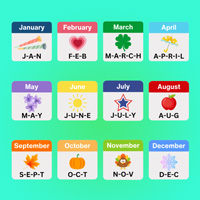
Tips for Parents: Sign Language Learning Tools You Can Use with Kids Home from School
Where I live in Michigan, our Governor has declared all K-12 schools to close from March 16 to April 5. This causes all types of stresses for parents – work, childcare, meals, and financial stresses. Not to mention, feeling fully unprepared for making sure your child doesn’t academically fall behind during this extended time away from school.
Every school district (even down to individual schools and classrooms) can handle school closures differently. Where we live, our school district is offering free “grab and go” breakfast and lunches with curbside pickup to help support families who count on school to provide meals for their children during the day and are financially stressed to take on all those meals at home. Our district and teachers have encouraged us to use routines at home to provide our kids a sense of stability and security during this atypical time. There is currently a district policy to not assign homework during this extended time off. This policy was formed in considering equity reasons – that not all students will have access to adults who can support them with assigned homework and continuing education during this time. However, by class, our teachers have been sending some lists of suggested online resources to use at home. These tend to be resources that are already used at school that our kids are already familiar with. It’s good to have a few go-to resources, but it can still feel overwhelming.
If you have a deaf child or a child that is learning or using American Sign Language, we encourage you to keep signing during any break from school. How you use Signing Savvy may vary depending on your own signing level and the signing level of your child.
Here are some tips on how to use Signing Savvy learning tools with your children:
-
Use the Sign of the Day as a Conversation Starter
Many teachers like to look at the Sign of the Day as a class each day, and it’s a great thing to do at home too. You can start the day with the Sign of the Day or as a conversation starter at mealtimes. There are a few components to the Sign of the Days that make them a great learning tool and a place to start.
- Look at the Sign of the Day together and practice it together.
- Read the note describing why that sign is the Sign of the Day. It may be because of a special recognized day, from National Learn About Butterflies Day to St. Patrick’s Day, or it may be to highlight Deaf culture with information about a person or historical event. Learning about the "why" can be an interesting topic of discussion.
- Make sure you don’t miss the example sentence(s) of the day! There is always a signed sentence that uses the Sign of the Day in it. Seeing the sign used in context helps with language learning. Read the English text for the sentence and then try to sign it yourself before clicking the button to watch the sentence. Did you sign it the same as in the example video? Remember there can be more than one "right" answer, so if you signed it differently, you may not necessarily be wrong. Look at the sign order and what signs were used to sign the full sentence in ASL.
- Look at the Sign of the Day together and practice it together.
-
Establish a Routine and Create a Schedule With Signs
I mentioned our district and teachers have encouraged us to use routines at home to provide our kids a sense of stability and security during this atypical time. We have an article with tips on using routines to create a language rich environment.
-
Use Word Lists If You Are Just Getting Started With Learning ASL
If you or your child is just starting your journey with learning ASL, we hope you have been working with one or more teachers that have helped you develop a vocabulary list of words that you should be working on and practicing at home.
If you need a place to start, we have a great set of pre-built word lists that are used in introductory ASL courses that you can use as a starting place. We also have a directory of pre-built word lists from you to choose from. You can use these wordlists to learn and review vocabulary. The quizzing and digital flash card tools are particularly helpful for this purpose.
-
Creating Word Lists to Practice and Study Specific Vocabulary
If you have vocabulary words from school that you know your student is specifically struggling with already, create a word list of signs for these words and practice the vocabulary together. For us, this is vocabulary words from past spelling tests and “sight” words used in reading literacy. We will practice this vocabulary through signing, cards we make with the words on them (you could also put a picture of the sign on the card), and writing them out.
-
Not Only Keep Signing, But Keep Reading
One thing I already know we’re going to miss during this time away from school is activities designed to encourage reading. Remember, March is "Reading Month." Our school has us log reading hours at home during this month and our teachers and principal have encouraged us to continue to do so, even while away from school. We have a classroom goal of 13,000 minutes and a school goal of 155,000 minutes and they are encouraging us to keep reading to help reach those goals. There is something great about the students still working on a group goal, even when they can’t be together. We have a series of articles on literacy and signing children’s books that may help you with reading at home.
-
Get Cooking!
Kids love to get their hands dirty, so get them in the kitchen for fun cooking and baking time. We also have a series of articles on Cooking Up Language with Signs.
We hope these tips gave you some good ideas of activities to do at home and learning tools to help you keep signing with your kids during any breaks from school.
ADVERTISEMENTS
 Tips for Reading with Deaf and Hard of Hearing Children
Tips for Reading with Deaf and Hard of Hearing Children 5 Tips for Creating a Language Rich Environment for Deaf Children Through Routines and Consistency
5 Tips for Creating a Language Rich Environment for Deaf Children Through Routines and Consistency Cooking Up Language with Signs: Language Learning and Teachable Moments Through Cooking
Cooking Up Language with Signs: Language Learning and Teachable Moments Through Cooking






